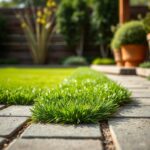Do You Have to Remove Grass Before Laying Artificial Grass? A Comprehensive Guide

When considering the installation of artificial grass, one common question arises: do you need to remove the existing natural grass? This comprehensive guide aims to address this concern by exploring the various factors involved in the decision. While some homeowners choose to eliminate the natural turf to ensure a smooth and stable foundation, others might opt to lay artificial grass over it. Understanding the benefits and potential drawbacks of each approach is crucial for achieving a successful installation. Join us as we delve into the best practices, considerations, and expert insights to make an informed decision for your artificial grass project.
Do You Have to Remove Natural Grass Before Laying Artificial Grass?
Removing natural grass before laying artificial grass is highly recommended for achieving the best results. While some may consider installing artificial grass over the existing lawn, it can lead to several issues, such as uneven surfaces, poor drainage, and potential growth of weeds beneath the synthetic layer. By removing the grass, you not only ensure a smoother and more stable foundation but also minimize the risk of any organic matter decomposing under the artificial turf. This process also allows for better installation techniques, contributing to the longevity and durability of the artificial lawn.
Benefits of Removing Existing Grass
Removing existing grass provides numerous benefits, including improved drainage and a level surface, which ultimately enhances the appearance and performance of the artificial grass. Furthermore, it prevents any potential weed growth and reduces the chances of pests that may thrive in the natural layer, ensuring a healthier environment for the synthetic lawn.
Process of Removing Natural Grass
The process of removing natural grass generally involves using a sod cutter or a shovel to dig out the existing turf. Once the grass is removed, it's crucial to clear any remaining roots and debris to create a clean and stable base for the artificial grass installation. This may require leveling the soil and compacting it to ensure proper drainage, which is essential for a long-lasting artificial lawn.
Alternative Options Without Removal
In some cases, homeowners might consider laying artificial grass over existing grass; however, this is not advisable. While it might save time and effort initially, it can lead to long-term complications like uneven surfaces, water pooling, and grass decay, which can damage the integrity of the synthetic grass. To avoid these issues, it is important to weigh the pros and cons carefully before deciding to install artificial grass directly over natural grass.
See also:
Cost Considerations
The cost of removing natural grass can vary based on the size of the area and the method chosen for removal. However, investing in the removal of grass can save money in the long run by extending the lifespan of the artificial grass and reducing maintenance costs associated with pest control and drainage problems. Homeowners should factor in these potential long-term savings when considering the initial investment in proper preparation.
Maintenance After Removal
After the natural grass is removed, maintaining the area prior to artificial grass installation is crucial. This includes monitoring for any remaining weeds or small plants that may resurface and ensuring that the base is compacted and level. Proper preparation and care at this stage will significantly affect the performance and appearance of the artificial grass once installed.
| Key Aspect | Description |
|---|---|
| Drainage | Removing grass improves water flow and prevents pooling. |
| Surface Leveling | A clean base creates a smoother and more visually appealing finish. |
| Weed Control | Eliminating existing grass helps prevent weeds from growing beneath the turf. |
| Pest Management | Removing natural vegetation reduces the habitat for pests. |
| Longevity | A proper foundation extends the life of the artificial grass. |
Benefits of Removing Natural Grass Before Installing Artificial Grass
When considering whether to remove natural grass before laying artificial grass, it is crucial to understand the benefits of this practice. Removing the existing grass allows for a cleaner and more even surface, which enhances the overall appearance and longevity of the artificial grass installation. Additionally, it helps to avoid potential weeds and pests that may thrive under the artificial layer, ensuring a healthier environment for your lawn. Furthermore, by properly preparing the ground, including potentially adding a drainage layer or leveling it out, you set the stage for optimal performance of your new grass, leading to a more enjoyable experience for activities such as sports, play, or relaxation.
How to Remove Natural Grass Effectively
To effectively remove natural grass, one should start by cutting it short to facilitate the process. Using a sod cutter or a shovel, you can lift the grass in sections for easier handling. When lifting, make sure to remove any roots to reduce the risk of regrowth. Afterward, it’s advisable to check and amend the soil, ensuring it’s well-compacted and free from debris, which sets a sturdy foundation for your artificial grass.
Consequences of Not Removing Grass
Not removing the existing grass can lead to several issues. Firstly, natural grass can continue to grow even underneath the artificial surface, leading to bumping and uneven areas over time. This not only diminishes the appearance of the lawn but can also create hazards for users. Moreover, the organic matter may retain moisture, potentially causing mold or fungus to develop, which can compromise the integrity of the artificial grass.
See also:
Alternatives to Complete Grass Removal
If complete grass removal seems daunting, there are alternatives that can be considered. One option is to suppress the existing grass using a layer of landscape fabric or cardboard, which blocks sunlight and prevents growth. However, this method may still present risks over time, such as uneven surfaces or residual vegetation breaking through. It’s crucial to weigh the long-term effects versus immediate convenience when deciding on this approach.
Preparing the Soil After Grass Removal
After grass removal, preparing the soil is a vital step before installing artificial grass. Gather any remaining debris, and consider aerating the soil to promote drainage. You might also want to apply a layer of crushed stone or gravel to further enhance drainage capabilities while providing a level base, which is essential for a successful installation. Adding a layer of sand can also help in achieving a smooth surface that allows for better stability and longevity of the artificial turf.
Cost Implications of Grass Removal
The process of removing natural grass can have several cost implications that homeowners should consider. While DIY removal may save money, hiring professionals can ensure a thorough job and reduce the risk of mistakes, which can lead to further costs down the line. The expenses may include renting equipment like sod cutters and disposal fees for the removed grass. It’s important to assess these costs against the potential long-term benefits your artificial grass installation will provide.
Questions from Our Readers
Do you have to remove grass before laying artificial grass?
Removing natural grass before laying artificial grass is highly recommended. This ensures that the surface is level and free from weeds, which could damage the synthetic turf. By removing the existing grass, you also improve drainage and prevent pests from nesting in the soil.
What methods can be used to remove existing grass?
There are several effective methods to remove grass, including using a sod cutter, manual removal with a shovel, or applying a herbicide to kill the grass before removal. Each method has its advantages, but the sod cutter is often the quickest and most efficient for larger areas.
See also:
Can I lay artificial grass over existing grass?
While it is technically possible to lay artificial grass over existing grass, it is not advisable. This can lead to uneven surfaces, potential weed growth, and drainage issues. For the best results and longevity of your artificial turf, it is essential to remove the natural grass beforehand.
What are the benefits of removing grass before installation?
Removing grass before installing artificial grass ensures a cleaner installation and enhances the durability of the turf. It helps maintain a flat surface, reduces the chance of weeds, and improves drainage, which are crucial factors for the longevity and appearance of your artificial lawn.

If you want to read more articles like Do You Have to Remove Grass Before Laying Artificial Grass? A Comprehensive Guide, we recommend you check out our Turf category.
Leave a Reply
Related Articles